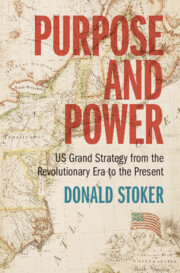Book contents
- Purpose and Power
- Purpose and Power
- Copyright page
- Dedication
- Contents
- Figures
- Maps
- Abbreviations
- Thinking about Grand Strategy in Peace and War
- Part I From Backwater to Great Power
- Part II From Great Power to Superpower
- 7 Stepping upon the Global Stage, 1913–1921
- 8 The Interwar Interlude, 1921–1939
- 9 Moving Astride the World: The Second World War, 1939–1945
- 10 The Hot Peace and the Korean War, 1945–1953
- 11 The Hot Peace: The Eisenhower, Kennedy, And Johnson Years, 1953–1969
- 12 The Vietnam War, 1961–1969
- 13 Détente and Defeat: Nixon, Ford, and Vietnam, 1969–1977
- 14 For Want of a Vision: The Carter Years, 1977–1981
- 15 Winning the Hot Peace: Reagan’s Great-Power Competition, 1981–1990
- Part III The Post–Cold War World
- Part IV Retreat and Defeat
- Acknowledgements
- Notes
- Index
13 - Détente and Defeat: Nixon, Ford, and Vietnam, 1969–1977
from Part II - From Great Power to Superpower
Published online by Cambridge University Press: 11 January 2024
- Purpose and Power
- Purpose and Power
- Copyright page
- Dedication
- Contents
- Figures
- Maps
- Abbreviations
- Thinking about Grand Strategy in Peace and War
- Part I From Backwater to Great Power
- Part II From Great Power to Superpower
- 7 Stepping upon the Global Stage, 1913–1921
- 8 The Interwar Interlude, 1921–1939
- 9 Moving Astride the World: The Second World War, 1939–1945
- 10 The Hot Peace and the Korean War, 1945–1953
- 11 The Hot Peace: The Eisenhower, Kennedy, And Johnson Years, 1953–1969
- 12 The Vietnam War, 1961–1969
- 13 Détente and Defeat: Nixon, Ford, and Vietnam, 1969–1977
- 14 For Want of a Vision: The Carter Years, 1977–1981
- 15 Winning the Hot Peace: Reagan’s Great-Power Competition, 1981–1990
- Part III The Post–Cold War World
- Part IV Retreat and Defeat
- Acknowledgements
- Notes
- Index
Summary
Richard Nixon and Henry Kissinger believed they could remake the international order in American interests to achieve greater international stability and reduce American costs and commitments. This required bringing China out of its isolation, which was an international bombshell. Under the Nixon Doctrine, the US would maintain its relationships but now bear less of the burden. Nixon and Kissinger used “linkage” to resolve issues with the Soviet Union and launched détente with Moscow. Moscow did what it wanted. Middle East involvement intensified, particularly with Israel and Saudi Arabia. Nixon wanted out of Vietnam but did not want to abandon South Vietnam. Nixon and Kissinger tried to push Hanoi to its breaking point while negotiating America’s exit and drawing down. This was contradictory. Creighton Abrams ran the US war. He was ordered to abandon attrition but continued “search and destroy” operations and pacification. Vietnamization – turning the war over to South Vietnam – became a key strategy element. The US bombed and invaded the North’s sanctuary in Cambodia, backed a South Vietnamese invasion of Laos, helped thwart North Vietnam’s 1972 Easter Offensive into South Vietnam, partially via LINEBACKER, and coerced North Vietnam into signing a 1973 US withdrawal agreement via LINEBACKER II. The North conquered the South in 1975. Gerald Ford succeeded Nixon.
Keywords
- Type
- Chapter
- Information
- Purpose and PowerUS Grand Strategy from the Revolutionary Era to the Present, pp. 446 - 476Publisher: Cambridge University PressPrint publication year: 2024



